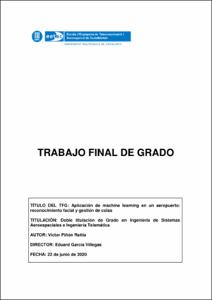Mostra el registre d'ítem simple
Aplicación de machine learning en un aeropuerto: reconocimiento facial y gestión de colas
| dc.contributor | García Villegas, Eduard |
| dc.contributor.author | Piñon Rattia, Victor Jose |
| dc.contributor.other | Universitat Politècnica de Catalunya. Departament d'Enginyeria Telemàtica |
| dc.date.accessioned | 2020-07-15T11:53:02Z |
| dc.date.available | 2020-07-15T11:53:02Z |
| dc.date.issued | 2020-07-03 |
| dc.identifier.uri | http://hdl.handle.net/2117/192967 |
| dc.description.abstract | In the last few years, Machine learning algorithms have enabled the development of many applications, which are used by a lot of people on a daily basis. This applications provide functionalities in fields as diverse as radiology or virtual assistants with voice recognition. Many of this applications, would have been nearly impossible to develop without the progress made in the field among the last decades, but are now possible with machine learning algorithms. It is also likely, because of the current growth in this topic, that we will continue to see more and more applications being developed using machine learning in the next years. The main goal of this work is to find and explore potential applications of machine learning on the management of an airport. As a proof of concept, two particular applications have been deeply studied: face recognition and prediction of waiting times in airport queues. Regarding face recognition, there will be an edge computing-based development, implementation and evaluation and there will also be an implementation and evaluation of a cloud-based model, which uses Azure Face API. Both implementations are done using a Raspberry Pi, with the intent of comparing the run time and energy consumption of the two approaches. The obtained face recognition results are good in both edge and cloud models, but they are better in the cloud model, which is excellent in face recognition quality. Regarding run time and energy consumption, the cloud model also wins, with the best performance being when used with a cable internet connection between the camera-equipped end device and the network. With respect to the tool for predicting airport passport control waiting times, the chosen methodology involved different steps. A first phase, pre-processing public data of airport waiting times. Then, a second phase in which several machine learning algorithms are tested to evaluate which one performed the best. Finally, the chosen machine learning algorithm is optimized. The results obtained with this tool are really promising and they could be a starting point for future applications using this model in airport queues. |
| dc.description.abstract | Los algoritmos de machine learning han permitido desarrollar, durante los últimos años una gran cantidad de aplicaciones que son utilizadas por muchas personas a diario, estas proporcionan funcionalidades en campos tan diversos como la radiología o los asistentes virtuales controlados por voz. Muchas de estas aplicaciones, hubiesen sido prácticamente imposibles de desarrollar sin los avances realizados en esta materia durante las últimas décadas, pero con algoritmos de machine learning son posibles. El principal objetivo de este trabajo es encontrar y explorar aplicaciones potenciales de machine learning en la gestión de un aeropuerto. Como prueba de concepto, se han estudiado en profundidad dos aplicaciones: el reconocimiento facial y la predicción del tiempo de espera encolas en aeropuertos. En lo que respecta al reconocimiento facial, se desarrolla, implementa y evalúa un modelo de reconocimiento facial edge, y también se implementa y evalúa un modelo de reconocimiento facial cloud utilizando la Face API de Azure. Ambas implementaciones se realizan en Raspberry Pi, con la intención de comparar el tiempo y consumo de energía que se requiere para cada uno de los dos modelos.Los resultados de reconocimiento facial obtenidos son buenos en ambos casos, pero son superiores en el modelo cloud, tanto en calidad del reconocimiento, como en tiempo y consumo de energía, siendo la mejor opción utilizar el modelo cloud con una conexión a internet mediante cable.Respecto a la herramienta para predecir el tiempo de espera en cola en un aeropuerto, se ha requerido un procesado de datos públicos sobre tiempos de esperas en aeropuertos. A continuación, se ha hecho una comparación entre varios algoritmos para ver cuál daba mejores resultados y, finalmente, se ha optimizado el algoritmo que ha dado mejores resultados.Los resultados obtenidos con esta herramienta son prometedores, y permiten ampliar el modelo desarrollado en este trabajo para futuras aplicaciones relacionadas con las colas en aeropuertos. |
| dc.language.iso | spa |
| dc.publisher | Universitat Politècnica de Catalunya |
| dc.rights.uri | http://creativecommons.org/licenses/by-nc-sa/3.0/es/ |
| dc.subject | Àrees temàtiques de la UPC::Informàtica |
| dc.subject.lcsh | Human face recognition (Computer science) |
| dc.subject.lcsh | Machine learning |
| dc.subject.other | IoT |
| dc.subject.other | Machine Learning |
| dc.subject.other | Airport |
| dc.title | Aplicación de machine learning en un aeropuerto: reconocimiento facial y gestión de colas |
| dc.type | Bachelor thesis |
| dc.subject.lemac | Reconeixement facial (Informàtica) |
| dc.subject.lemac | Aprenentatge automatic |
| dc.rights.access | Open Access |
| dc.date.updated | 2020-07-04T04:10:50Z |
| dc.audience.educationlevel | Estudis de primer/segon cicle |
| dc.audience.mediator | Escola d'Enginyeria de Telecomunicació i Aeroespacial de Castelldefels |
| dc.audience.degree | GRAU EN ENGINYERIA DE SISTEMES AEROESPACIALS/GRAU EN ENGINYERIA TELEMÀTICA (Pla 2015) |
Fitxers d'aquest items
Aquest ítem apareix a les col·leccions següents
-
Grau en Enginyeria de Sistemes Aeroespacials + Enginyeria Telemàtica (Pla 2015) [35]
Doble titulació



